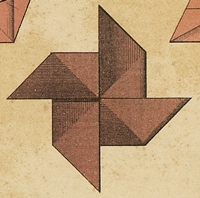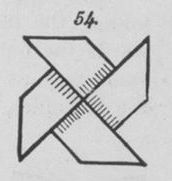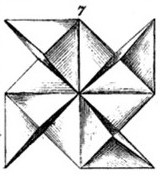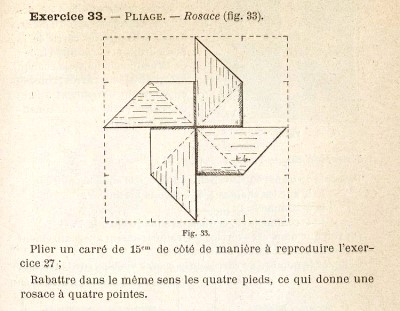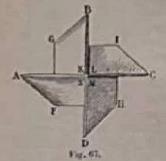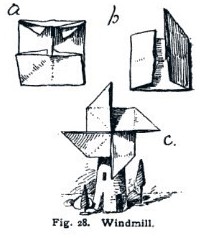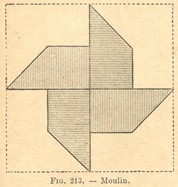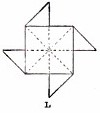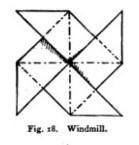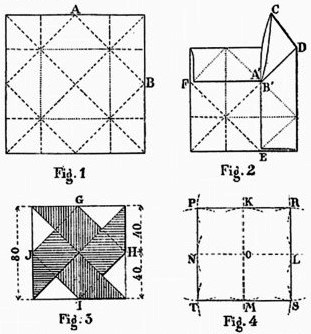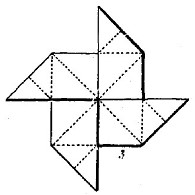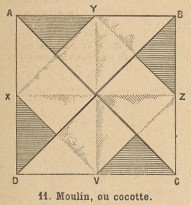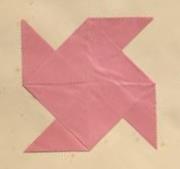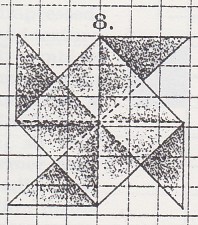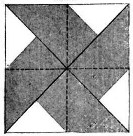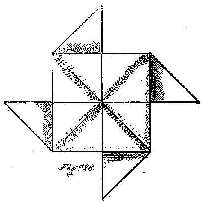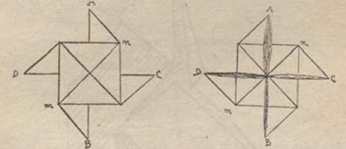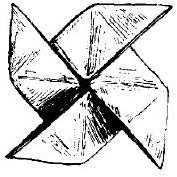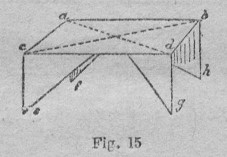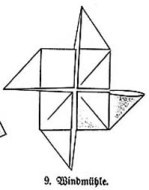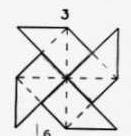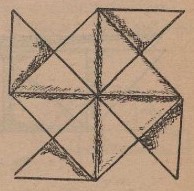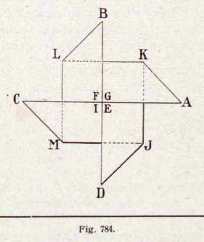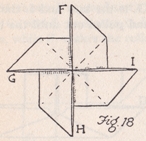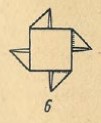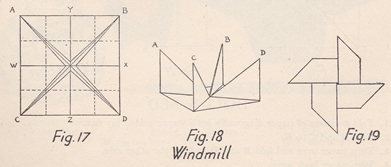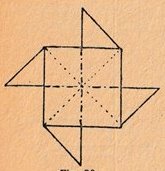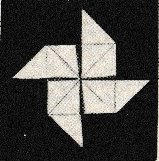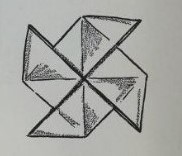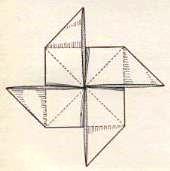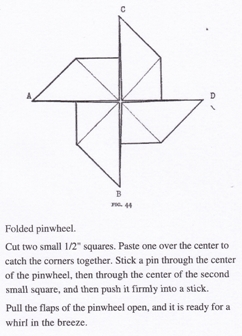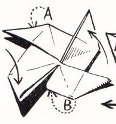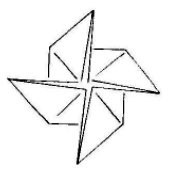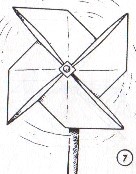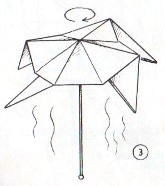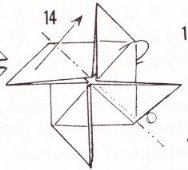| The Public Paperfolding History Project
Last updated 26/9/2025 x |
|||||||
| The Windmill and the Bi-colour Windmill | |||||||
| This
page is being used to collect information about the
history of the paperfolding design known as the Windmill
and its derivative design, the Bi-colour Windmill. Please
contact me if you know any of this information is
incorrect or if you have any other information that
should be added. Thank you. The Windmill is made by folding alone without using cuts. Information about other kinds of paper windmills can be found here. ********** In China (and in publications by Chinese authors) 1914 Diagrams for the Windmill appear in 'Zhe zhi tu shuo' (Illustrated Paperfolding), compiled by Gui Shaolie, which was published by the Commercial Press in Shanghai in Ming guo 3 (1914). The design is made via the Cigar Case - which is not, however, presented as a design in its own right.
********** In Japan (and in publications by Japanese authors) In his article 'History of Origami in the East and the West before Interfusion', published in 'Origami 5: Fifth International Meeting of Origami, Science, Mathematics and Education', Koshiro Hatori asserts that, ''Many of the European origami models contained in Krause-Boelte's book (ie 'The Kindergarten Guide', published in 1881) are not included in contemporary Japanese records. The pig, house, sofa (also known as piano or organ), balloon (waterbomb), arrow (paper plane), salt cellar (cootie catcher), bird (pajarita or cocotte) and windmill ... were all born in Europe and imported into Japan along with the kindergarten system.' An accompanying illustration shows that this statement refers to the uncut design. ********** 1885 A drawing of the Windmill appeared in 'Kindergarten Shoho' (Preliminary Kindergarten) by Iijima Hanjuro, which was copyrighted on October 4th Meiji 17 (1884) and published by Fukuda Senzo in August of Meiji 18 (1885).
********** 1892 The Windmill also appears in 'Kani Shukogaku' (Simple Handicraft) by Tamotsu Shibue, which was published in Tokyo in 1892.
********** 1904 Diagrams for the Windmill appear in 'Shukouka Kyoju Shishin: Maiji Haitou' by Hyojiro Nakagaki, which was published by Kenseikai in Tokyo in 1904.
********** 1908 Diagrams that show how to convert the Boat with Sail into the Windmill appear in 'Origami zusetsu' (Illustrated Origami) by Sano Shozo, which was published in Tokyo in 1908.
********** 1912 A drawing of the Windmill appears in a monozukushi-e print, by an unknown artist, but said to be from the Meiji era. I have temporarily assigned it the date of 1912, the last year of that era, pending the discovery of more accurate information.
********** 1927 A drawing of the Windmill appears in an illustration by Takei Takeo in a 1927 issue of the children's magazine 'Kodomo No Kuni' (The Land of Children).
(Note that although this appears to be a Bicolour Windmill it is probably not. The illustration this drawing is taken from shows several designs in multiple colours which do not correspond to the folding method.) ********** The design also appears: 1935 In 'Origami Moyo, Book Two' by Kawarazaki Kodo, which was published in Japan in 1935, contains a print showing the Windmill.
********** 1944 As 'Kazaguruma' in 'Origami Shuko' by Isao Honda, which was published in 1944.
********** 1954 The Bicolour Windmill appears in 'Atari Origami Geijuitsu' by Akira Yoshizawa, which was published by Origami Geijutsu Sha in 1954.
********** 1957 The Windmill appears in 'Origami: Book One' by Florence Sakade, which was published by the Charles E Tuttle Company in Rutland, Vermont and Tokyo in 1957.
********** 1959 The Bi-colour Windmill appears in 'How to Make Origami' by Isao Honda, which was published by Toto Shuppan Co. Ltd in Japan. by McDowell Obolensky of New York in the USA and by Museum Press Ltd of London in England, in 1959.
********** 1960 As 'A Pin-wheel' in 'All About Origami' by Isao Honda, which was published by Toto Bunka Company, Limited in Tokyo in 1960.
********** 1962 As 'A Windmill' in 'Living Origami Book 2' by Isao Honda, which was published by Charles E. Tuttle Co. Inc in Rutland Vermont in 1962.
********** 1965 The Bi-colour Windmill also appears, as 'Pinwheel', in 'The World of Origami' by Isao Honda, which was published in the USA by Japan Publications Trading Company in 1965.
********** 1967 As 'Pinwheel' in 'Origami Festival' by Isao Honda, which was published by Japan Publications Inc in Tokyo in 1967.
********** 1970 As 'Pinwheel' in 'Origami Nippon' by Isao Honda, which is a paperback book published by Honda Origami Studio in Tokyo in 1970.
********** In Europe and the Americas 1859 The list of paper folding designs in the 'Manuel Pratique de Jardins D'Enfants de Friedrich Froebel, which was compiled by J F Jacobs and published in Brussells and Paris in 1859, includes a 'moulin à vent'. From its position in the list it can be inferred that this is the Windmill. ********** 1863 'De Kleine Papierwerkers 1: Wat men van een stukje papier al maken kan: Het vouwen' (The Small Paperwork 1: What one can make from a piece of paper: Folding) by Elise Van Calcar, which was published by K H Schadd in Amsterdam in 1863 contains a drawing of 'de molen' (the mill).
********** 1869 A design called 'Ein Windmuhle', which is not illustrated, but which from the context is most probably the Windmill, appears in a list of designs in 'Der Kindergarten' by Hermann Goldammer, which was published by Habel in Berlin in 1869. ********** 'Paradise of Childhood' by Edward Wiebe, which was published by Milton, Bradley and Company in Springfield, Massachusetts in 1869, and is effectively a translation of Goldammer's 'Der Kindergarten', similarly includes a 'wind-mill' in its list of Forms of Life. ********** The design also appears: 1873 In 'Exercices et Travaux pour les Enfants Selon la Méthode et les Procédés de Pestalozzi et de Froebel' by Fanny and Charles Delon, which was published by Librairie Hachette in Paris in 1873
********** As 'Windmuhle' i n 'Die Praxis Des Kindergartens' by August Koehler, which was published by Herman Bohlau in Weimar in 1873. iin this work the Windmill is made from the Jacket by opening out the collar and waistband. The result is a Windmill folded from a blintzed square.
********** In 'Bilder aus dem Kindergarten fur Mutter und Erzhieherrinen' by Ernst Barth, which was published in Leipzig in 1873.
********** 1874 In the revised version of 'Der Kindergarten' by Hermann Goldammer which was published by Carl Babel in Berlin in 1874.
********** 1876 In 'Des Kindes Erste Beschaftigungsbuch' by E Barth and W Niederley, which was first published in Bielefeld and Leipzig, and the foreword of which is dated October 1876.
********** 1877 In 'Kindergarten Practice' by Mary Gurney, which is a substantially abridged version, in two parts, of 'Die Praxis Des Kindergartens' by Auguste Koehler. The second part, 'Froebel's Plane Surfaces', contains sections dealing with paper folding, cutting and weaving. The date of the first edition is not known. The second edition was published in 1877 in London by A N Myers and Co.
********** The design also appears in part 2 'Die Praxis' of 'Theoretisches und praktisches Handbuch der Fröbelschen Erziehungslehre' by Bertha von Marentholtz-Bülow, which was published by George H Wigand in Kassel in 1887, where it is alsoused as the base of Forms of Beauty.
********** As 'Un sorte de rosace' (a sort of rosette) in 'Cours de Travail Manuel (Pour les Garcons) - Premiere Partie - Cours Elementaire' by A Planty, which was published by Gedalge Jeune in Paris in 1887
********** 1879 In 'Manual Teorico-Practico de Educacion Parvulos' by D Pedro de Alcantara Garcia, which was published in Madrid in 1879.
********** 1880 There is mention of a design called 'The Windmill' in 'The Kindergarten Principle' by Mary J Lyschinska, which was published in London in 1880 by Wm Isbister Ltd, but no illustration is given. ********** 1882 This design also appears: In part two of 'The Kindergarten Guide' by Maria Kraus Boelte and John Kraus, which was probably first published in 1882 by E. Steiger and Company in New York.
********** 1883 As 'Windmuhlflugel' in 'Der Kindergarten' by A S Fischer, which was published by Alfred Holder in Wien in 1883.
********** 1887 As 'Rosace' in 'Le Travail Manuel a L'ecole Primaire' by M. Coste et J. Lapassade, which was published by Lafon, Vve Ribaut et Tonnet in Pau and A Jeande in Paris in 1887.
********** 1890 As 'Moulin' in 'Le travail manuel a l'ecole et dans la famille' by MM, Bertrand, Toussaint and Gombert, which was published by Loucene, Oudin et ces Editeurs in Paris in 1890.
********** 1891 In 'Pleasant Work for Busy Fingers' by Maggie Browne, which was published by Cassell and Company in London in 1891. This book is an English version of 'Des Kindes Erste Beschaftigungsbuch' enhanced by the addition of a few extra designs. ********** 1892 The Windmill is mentioned in the instructions for making the double boat in 'Le Travail Manuel a L'ecole Primaire' by Jully & Rocheron, which was published by Librairie Classique Eugene Belin in Paris in 1892, though not presented as a design in its own right..
********** The Windmill also appears: In 'The Prang Primary Course in Art Education: Part 1: The First Primary Year' by Mary Dana Hicks and Josephine C Locke, which was published by the Prang Educational Company in Boston in 1892.
********** 1893 In 'L'Annee Preparatoire de Travail Manuel' by M P Martin, which was published by Armand Collin & Cie in Paris in 1893.
********** As 'Pin-Wheel' in 'Practical Suggestions for Kindergartners, Primary Teachers and Mothers' by Jeannette R Gregory, which was published by C B Woodward and Co in St Louis in 1893.
********** In 'Paper and Scissors in the Schoolroom' by Emily Weaver, which was published by Milton Bradley Company in Springfield, Massachusetts in 1893.
********** 1894 As 'Moulin' in an article by J Marteau in 'Manuel General de L'Instruction Primaire' of 6th January 1894.
********** As 'Le Moulin a Vent' in 'Jeux et Occupations Pour les Petits: Guide des Mères et des Institutrices' by Henriette Suzanne Brés was published by Librairie Classique Fernand Nathan in Paris in 1894.
********** 1895 In 'L'enseignement manuel dans les ecoles du degre primaire (garcons)' by Rene Leblanc, which was published by Librairie Larousse in Paris in 1895.
********** In a sample book of Froebelian paperfolds and papercuts etc made by by Laura B Thompson in 1895.
********** As 'The Sails of a Windmill' in 'Course of Paperfolding' by Eleonore Heerwart, which was published by Charles and Dible in London and Glasgow in 1895.
********** 1897 As 'Moulin' in 'Pliage et Decoupage du Papier' by C Savineau, which was published by Librairie Hatchette et Cie in Paris in 1897.
********** In Lois Bates' 'Kindergarten Guide', which was first published by Longmans, Green and Co in London in 1897.
********** 1899 In an article in El Monitor 316 of 31st July 1899.
********** 1903 In 'La Ensenanza del Trabajo Manuel' by Pedro de Alcántara García and Teodosio Leal y Quiroga, which was published in Madrid in 1903.
********** 1904 In 'Guia Practica del Trabajo Manual Educativo' by Ezequiel Solana, which was published by Editorial Magisterio Español in Madrid in 1904.
********** 1907 As 'Estrella de mar' (Starfish), despite only having four arms, in an article titled 'El trabajo manual escolar' by Vicente Casto Legua in the January 1907 issue of the Spanish magazine 'La Escuela Moderna' which was published in Madrid by Los Sucesores de Hernando.
********** 1909 In 'Petit Manuel de Travaux d'Amateurs' by H de Graffigny, which was published by Collection A L Guyot in Paris in 1909.
********** 1910 As 'Windmühle' in Part 2 'Das Flechten' of 'Die Frobelschen Beschaftigungen' by Marie Muller-Wunderlich, which was published by Friedrich Brandstetter in Leipzig in 1910.
********** As 'Windmuhle' in 'Allerlei Papierarbeiten' by Hildergard Gierke and Alice Kuczynski, which was published by Drud und Verlag B G Teubner in Leipzig and Berlin in 1910.
********** As 'Windmill or Pinwheel' in 'Educational Handwork' by T B Kidner, which was published by The Educational Book Company Limited in Toronto in 1910.
********** 1914 As 'El molino' in 'El Trabajo Manual en la Escuela' by Félix Martí Alpera, which was published by Libreria de los Sucesores de Hernando in Madrid in 1914.
********** 1918 As 'Molina de viento' in 'Ciencia Recreativa' by Jose Estralella, which was published by Gustavo Gili in Barcelona in 1918. No illustration provided.
********** 1927 As 'Muhlchen' in 'Lustiges Papierfaltbüchlein' by Johanna Huber, which was published by Otto Maier in Ravensburg, Germany, probably in 1927.
********** 1928 'Fun with Paperfolding' by William D Murray and Francis J Rigney, which was published by the Fleming H Revell Company, New York in 1928, contains a version of the Windmill folded from a blintzed windmill base.
********** c1929 As 'Molino' in booklet 1 of 'Trabajos Manuales Salvatella - Plegado de figuras de papel', which were published by Editorial Miguel A Salvatera in Barcelona, pobably in or around 1929.
********** 1931 The revised 3rd edition of 'Lustiges Papierfaltbüchlein' by Johanna Huber, which was published by Otto Maier in Ravensburg, Germany in 1931, includes a project to combine Windmills into this decoration.
********** 1936 The design appears as 'Windmuhle' in 'Allerlei Papierarbeiten' by Hilde Wulff and Carola Babick, which was published in Leipzig and Berlin in 1936.
********** 1937 'Paper Toy Making' by Margaret Campbell, which was first published by Sir Isaac Pitman and Sons Ltd in London, probably in 1937, although both the Foreword and Preface are dated 1936, which argues that the book was complete at that date.
********** 1939 As 'Molinete' in 'Trabajo Manual Educativo' by Araminta V Aramburu, which was published by F Crespillo in Buenos Aires in 1939.
********** As 'Molinete' in 'Plegado' by Rufino Yapur, which was published by Editores Independencia in Buenos Aires in 1939.
********** As 'A Windmill' in 'Fun with Paper' by Joseph Leeming, which was published by Spencer Press Inc in Chicago in 1939.
********** 1940 In 'El Plegado y Cartonaje en la Escuela Primaria' by Antonio M Luchia and Corina Luciani de Luchia, which was published by Editorial Kapelusz in Buenos Aires in 1940.
********** 1948 As the 'Pinwheel' in 'The Art of Chinese Paper folding for Young and Old' by Maying Soong, which was published by Harcourt Brace and Company of New York in 1948.
********** 1951 As 'Molinete' in Plegado laminas published by Della Penna, April 1951.
********** 1956 As the 'Windmill' in 'Paper Magic' by Robert Harbin, which was published by Oldbourne in London in 1956, as part of the 'Multiform' sequence.
********** 1952 As 'Molino' in 'Una Hoja de Papel' by Lorenzo Herrero, which was published by Miguel A Salvatella in Barcelona in 1952.
********** 1963 In the second edition of 'Het Grote Vouwboek' by Aart van Breda, which was published by Uitgeverij van Breda in 1963. This book also includes a hot air driven adaptation of the design.
********** 1964 As the 'Windmill' in 'Secrets of Origami', by Robert Harbin, which was published by Oldbourne Book Company in London in 1964, as part of the Multiform sequence.
********** |
|||||||

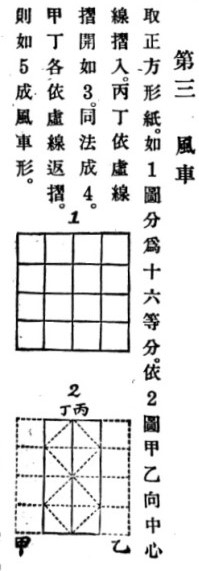
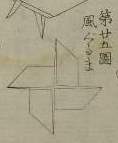
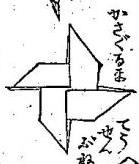
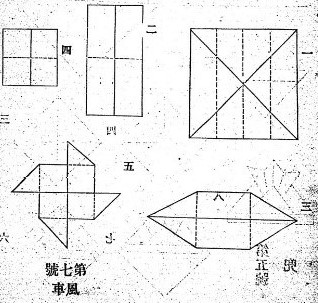
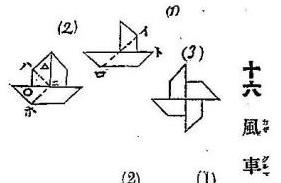
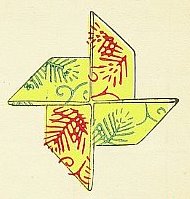
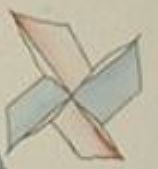
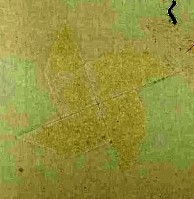

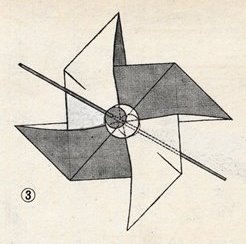
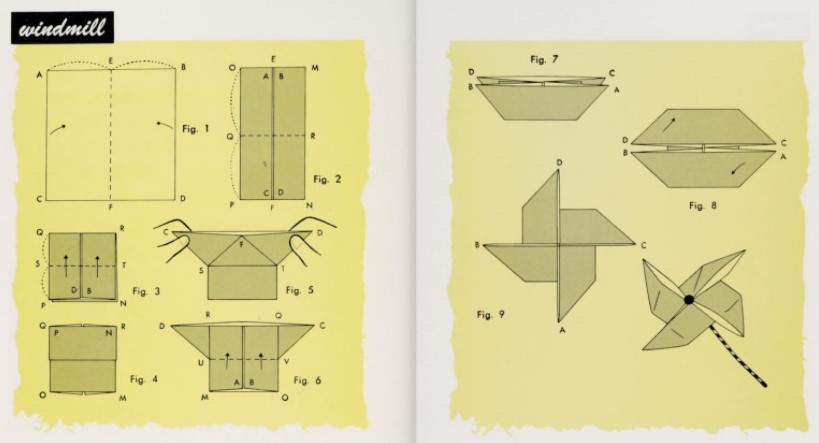
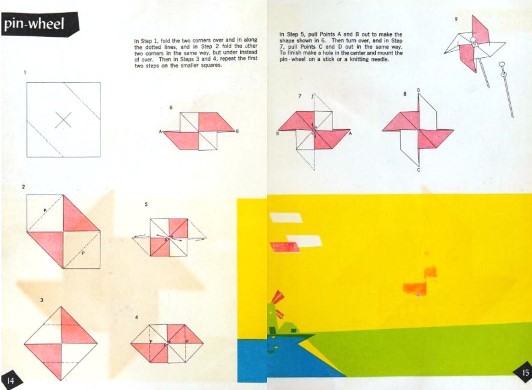


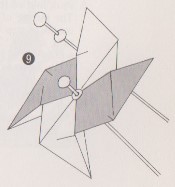


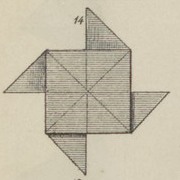
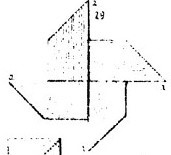

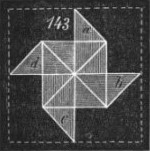
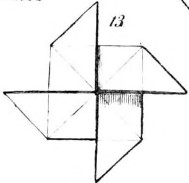
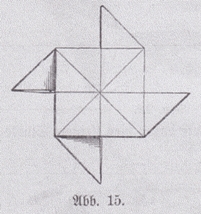

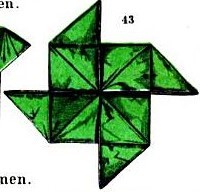 .
.